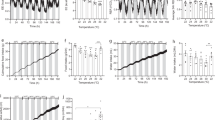Abstract
-
1.
Thermoregulation and non-shivering thermogenesis have been studied in the genetically diabeticobese (db/db) mouse.
-
2.
At all environmental temperatures between 33 and 10°C the body temperature of the diabetic mice was lower than that of the normal littermates, the difference varying from 1.1°C at 33°C to 4.5°C at 10°C.
-
3.
At 4°C the diabetic mice rapidly died (3.2 h) of hypothermia while the normal mice maintained their body temperature within the normal range.
-
4.
At 23°C the diabetic animals exhibited a diurnal rhythm in body temperature which was similar in both phase and amplitude to the controls, but at every point throughout the 24h cycle the temperature of the mutants was lower by 1–2°C.
-
5.
The resting metabolic rate at thermoneutrality (33°C) was higherper whole animal for the diabetics than for the normals. However, at temperatures below thermoneutrality the converse was observed; between 30 and 4°C the RMR of the mutants was lower than the controls by approximately 25%.
-
6.
The capacity for non-shivering thermogenesis in diabetic mice was only one-half that found in normal animals.
-
7.
The diabetic mouse has abnormalities in thermoregulation and non-shivering thermogenesis which are similar to those found in the genetically obese (ob/ob) mouse.
It is concluded that the high metabolic efficiency of the diabetic mouse, like that of the ob/ob mouse, can be explained by a reduced energy expenditure on thermoregulatory thermogenesis; this may represent a primary mechanism for the operation of the “thrifty genotype” associated with obesity and diabetes.
Similar content being viewed by others
References
Abraham, R. R., Dade, E., Elliot, J., Hems, D. A.: Hormonal control of intermediary metabolism in obese hyperglycemic mice. II. Level of plasma free fatty acid and immunoreactive insulin and liver glycogen. Diabetes20, 535–541 (1971)
Allan, J. A., Yen, T. T.: Lipolytic response of “diabetic” mice (db/db) to isoproterenol and propranolol in vivo. Experientia32, 836–837 (1976)
Alonso, L. G., Maren, T. H.: Effect of food restriction on body composition of hereditary obese mice. Am. J. Physiol.183, 284–290 (1955)
Bray, G. A., York, D. A.: Genetically transmitted obesity in rodents. Physiol. Rev.51, 598–646 (1971)
Bray, G. A., York, D. A., Yukimura, Y.: Activity of (Na++K+)-ATPase in the liver of animals with experimental obesity. Life Sci.22, 1637–1642 (1978)
Carnie, J. A., Smith, D. G.: Release of fatty acids from adipose tissue in genetically obese (ob/ob) mice. FEBS Lett.90, 132–134 (1978)
Chlouverakis, C.: Induction of obesity in obese-hyperglycaemic mice on normal food intake. Experientia26, 1262–1263 (1970)
Coleman, D. L.: Diabetes and obesity: thrifty mutants? Nutr. Rev.36, 129–132 (1978)
Coleman, D. L., Hummel, K. P.: Hyperinsulinemia in preweaning diabetes (db) mice. Diabetologia10, 607–610 (1974)
Cooper, K. E.: The body temperature “set-point” in fever. In: Essays on temperature regulation (J. Bligh and R. E. Moore, eds.). Amsterdam: North Holland 1972
Cox, J. E., Powley, T. L.: Development of obesity in diabetic mice pair-fed with lean siblings. J. Comp. Physiol. Psychol.91, 347–358 (1977)
Falconer, D. S., Isaacson, J. H.: Adipose, a new inherited obesity of the mouse. J. Hered.50, 290–292 (1959)
Herberg, L., Coleman, D. L.: Laboratory animals exhibiting obesity and diabetes syndromes. Metabolism26, 59–99 (1977)
Himms-Hagen, J., Desautels, M.: A mitochondrial defect in brown adipose tissue of the obese (ob/ob) mouse: reduced binding of purine nucleotides and a failure to respond to cold by an increase in binding. Biochem. Biophys. Res. Commun.83, 628–634 (1978)
Hummel, K. P., Dickie, M. M., Coleman, D. L.: Diabetes, a new mutation in the mouse. Science153, 1127–1128 (1966)
Hummel, K. P., Coleman, D. L. Lane, P. W.: The influence of genetic background on expression of mutations at the diabetes locus in the mouse. 1. C57BL/KsJ and C57BL/6J strains. Biochem. Genet.7, 1–13 (1972)
James, W. P. T., Trayhurn, P.: An integrated view of the metabolic and genetic basis of obesity. Lancet1976II, 770–773
Jansky, L.: Non-shivering thermogenesis and its thermoregulatory significance. Biol. Rev.48, 85–132 (1973)
Le Marchand-Brustel, Y., Jeanrenaud, B.: Pre-and post weanling studies on development of obesity in mdb/mdb mice. Am J. Physiol.234, E568-E574 (1978)
Lin, M. H., Romsos, D. R., Akera, T., Leveille, G. A.: Na+, K+-ATPase enzyme units in skeletal muscle from lean and obese mice. Biochem. Biophys. Res. Commun.80, 398–404 (1978)
Mitchell, D., Atkins, A. R., Wyndham, C. H.: Mathematical and physical models of thermoregulation. In: Essays on temperature regulation (J. Bligh and R. E. Moore, eds.). Amsterdam: North Holland 1972
Neel, J. V.: Diabetes mellitus: a “thrifty” genotype rendered detrimental by “progress”? Am. J. Hum. Genet.14, 353–362 (1962)
Stock, M. J.: An automatic, closed-circuit oxygen consumption apparatus for small animals. J. Appl. Physiol.39, 849–850 (1975)
Trayhurn, P., James, W. P. T.: Thermoregulation and non-shivering thermogenesis in the genetically obese (ob/ob) mouse. Pflügers Arch.373, 189–193 (1978)
Trayhurn, P., Thurlby, P. L., Woodward, C. J. H., James, W. P. T.: Thermoregulation in genetically obese rodents: the relationship to metabolic efficiency. In: Genetic models of obesity in laboratory animals (M. F. W. Festing, ed.). London: Macmillans 1979
Yen, T. T., Fuller, R. W., Pearson, D. V.: The response of “obese” (ob/ob) and “diabetic” (db/db) mice to treatments that influence body temperature. Comp. Biochem. Physiol.49A, 377–385 (1974)
York, D. A., Bray, G. A., Yukimura, Y.: An enzymatic defect in the obese (ob/ob) mouse: Loss of thyroid induced sodium — and potassium — dependent adenosinetriphosphatase. Proc. Natl. Acad. Sci. USA75, 477–481 (1978)
Zucker, L. M.: Efficiency of energy utilization by the Zucker hereditarily obese rat “fatty”. Proc. Soc. Exp. Biol. Med.148, 498–500 (1975)
Author information
Authors and Affiliations
Rights and permissions
About this article
Cite this article
Trayhurn, P. Thermoregulation in the diabetic-obese (db/db) mouse. Pflugers Arch. 380, 227–232 (1979). https://doi.org/10.1007/BF00582901
Received:
Issue Date:
DOI: https://doi.org/10.1007/BF00582901




